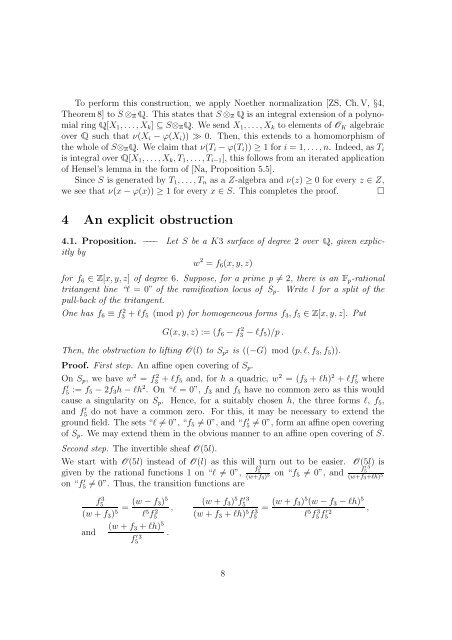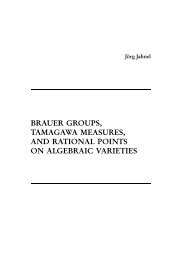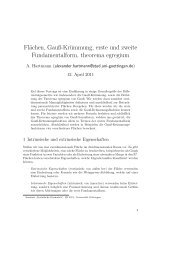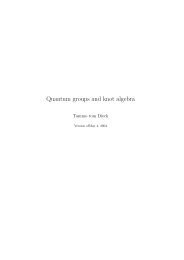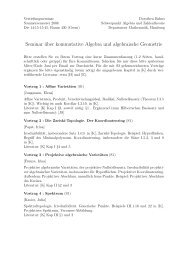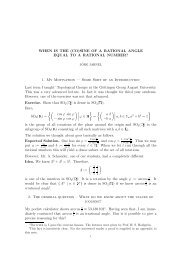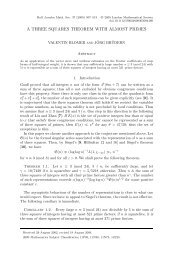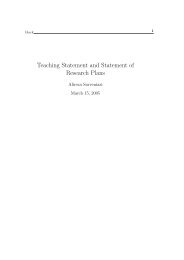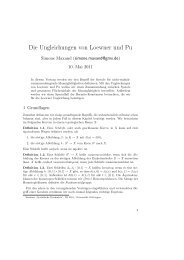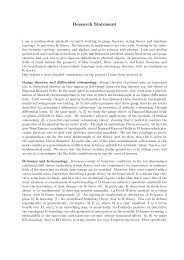The Picard group of a K3 surface and its reduction modulo p
The Picard group of a K3 surface and its reduction modulo p
The Picard group of a K3 surface and its reduction modulo p
You also want an ePaper? Increase the reach of your titles
YUMPU automatically turns print PDFs into web optimized ePapers that Google loves.
To perform this construction, we apply Noether normalization [ZS, Ch.V, §4,<br />
<strong>The</strong>orem8] to S ⊗É. This states that S ⊗Éis an integral extension <strong>of</strong> a polynomial<br />
ringÉ[X 1 , . . .,X k ] ⊆ S⊗É. We send X 1 , . . .,X k to elements <strong>of</strong> O K algebraic<br />
overÉsuch that ν(X i − ϕ(X i )) ≫ 0. <strong>The</strong>n, this extends to a homomorphism <strong>of</strong><br />
the whole <strong>of</strong> S⊗É. We claim that ν(T i − ϕ(T i )) ≥ 1 for i = 1, . . .,n. Indeed, as T i<br />
is integral overÉ[X 1 , . . .,X k , T 1 , . . ., T i−1 ], this follows from an iterated application<br />
<strong>of</strong> Hensel’s lemma in the form <strong>of</strong> [Na, Proposition 5.5].<br />
Since S is generated by T 1 , . . .,T n as a Z-algebra <strong>and</strong> ν(z) ≥ 0 for every z ∈ Z,<br />
we see that ν(x − ϕ(x)) ≥ 1 for every x ∈ S. This completes the pro<strong>of</strong>. □<br />
4 An explicit obstruction<br />
4.1. Proposition. –––– Let S be a <strong>K3</strong> <strong>surface</strong> <strong>of</strong> degree 2 overÉ, given explicitly<br />
by<br />
w 2 = f 6 (x, y, z)<br />
for f 6 ∈[x, y, z] <strong>of</strong> degree 6. Suppose, for a prime p ≠ 2, there is anp-rational<br />
tritangent line “l = 0” <strong>of</strong> the ramification locus <strong>of</strong> S p . Write l for a split <strong>of</strong> the<br />
pull-back <strong>of</strong> the tritangent.<br />
One has f 6 ≡ f 2 3 + lf 5 (mod p) for homogeneous forms f 3 , f 5 ∈[x, y, z]. Put<br />
G(x, y, z) := (f 6 − f 2 3 − lf 5 )/p .<br />
<strong>The</strong>n, the obstruction to lifting O(l) to S p 2 is ((−G) mod (p, l, f 3 , f 5 )).<br />
Pro<strong>of</strong>. First step. An affine open covering <strong>of</strong> S p .<br />
On S p , we have w 2 = f3 2 + lf 5 <strong>and</strong>, for h a quadric, w 2 = (f 3 + lh) 2 + lf 5 ′ where<br />
f 5 ′ := f 5 − 2f 3 h − lh 2 . On “l = 0”, f 3 <strong>and</strong> f 5 have no common zero as this would<br />
cause a singularity on S p . Hence, for a suitably chosen h, the three forms l, f 5 ,<br />
<strong>and</strong> f 5 ′ do not have a common zero. For this, it may be necessary to extend the<br />
ground field. <strong>The</strong> sets “l ≠ 0”, “f 5 ≠ 0”, <strong>and</strong> “f 5 ′ ≠ 0”, form an affine open covering<br />
<strong>of</strong> S p . We may extend them in the obvious manner to an affine open covering <strong>of</strong> S.<br />
Second step. <strong>The</strong> invertible sheaf O(5l).<br />
We start with O(5l) instead <strong>of</strong> O(l) as this will turn out to be easier. O(5l) is<br />
f5<br />
given by the rational functions 1 on “l ≠ 0”,<br />
3 f<br />
(w+f 3<br />
on “f<br />
) 5 5 5 ≠ 0”, <strong>and</strong><br />
′ 3<br />
(w+f 3 +lh) 5<br />
on “f 5 ′ ≠ 0”. Thus, the transition functions are<br />
f5<br />
3<br />
(w + f 3 ) = (w − f 3) 5<br />
,<br />
5 l 5 f5<br />
2<br />
(w + f 3 + lh) 5<br />
<strong>and</strong><br />
.<br />
f 5 ′ 3<br />
(w + f 3 ) 5 f ′ 5 3<br />
(w + f 3 + lh) 5 f 3 5<br />
= (w + f 3) 5 (w − f 3 − lh) 5<br />
l 5 f 3 5f ′ 5 2 ,<br />
8


